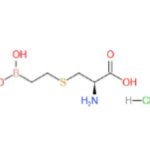BEC hydrochloride
$80.00 – $600.00
BEC hydrochloride (CAS No.: 222638-67-7), a slow-binding and competitive Arginase II inhibitor. >98% Purity.
Synonyms: BEC, BEC HCl, Arginase II inhibitor
For Research Use Only.
- Product Details
- Description
- Additional information
- More Offers
Description
APIM050409: BEC hydrochloride is a slow-binding and competitive Arginase II inhibitor with Ki of 0.31 μM and 30 nM at pH 7.5 and pH 9.5, respectively.
CAS No.: 222638-67-7
IUPAC/Chemical Name: S-(2-boronoethyl)-L-cysteine hydrochloride
Molecular Formula: C5H13BClNO4S
Molecular Weight: 229.49
Purity: >98% Purity
QC: Achiral and Chiral HPLCs, MS, NMR, and Quantitative Elemental Analysis Report
Solubility: Soluble in DMSO
Storage: Dry, dark and at 0 – 4 C for short term (days to weeks) or -20 C for long term (months to years).
Note: Please contact us for COA, Spectra, and SDS information.
Background Information:
Arginases catalyze the hydrolysis of L-arginine to yield L-ornithine and urea. Recent studies indicate that arginases, both the type I and type II isozymes, participate in the regulation of nitric oxide production by modulating the availability of arginine for nitric oxide synthase. Due to the reciprocal regulation between arginase and nitric oxide synthase, arginase inhibitors have therapeutic potential in treating nitric oxide-dependent smooth muscle disorders, such as erectile dysfunction. We demonstrate the competitive inhibition of the mitochondrial human type II arginase by N(omega)-hydroxy-L-arginine, the intermediate in the reaction catalyzed by nitric oxide synthase, and its analogue N(omega)-hydroxy-nor-L-arginine, with K(i) values of 1.6 microM and 51 nM at pH 7.5, respectively. We also demonstrate the inhibition of human type II arginase by the boronic acid-based transition-state analogues 2(S)-amino-6-boronohexanoic acid (ABH) and S-(2-boronoethyl)-L-cysteine (BEC), which are known inhibitors of type I arginase. At pH 7.5, both ABH and BEC are classical, competitive inhibitors of human type II arginase with K(i) values of 0.25 and 0.31 microM, respectively. However, at pH 9.5, ABH and BEC are slow-binding inhibitors of the enzyme with K(i) values of 8.5 and 30 nM, respectively.
Ki: Ki: 0.31 μM (BEC hydrochloride, at pH 7.5) and 30 nM (BEC hydrochloride, at pH 9.5) [1]
In Vitro: The X-ray crystal structure of the arginase-BEC complex has been determined at 2.3 Å resolution from crystals perfectly twinned by hemihedry. The structure of the complex reveals that the boronic acid moiety undergoes nucleophilic attack by metal-bridging hydroxide ion to yield a tetrahedral boronate anion that bridges the binuclear manganese cluster, thereby mimicking the tetrahedral intermediate (and its flanking transition states) in the arginine hydrolysis reaction. [2]
In Vivo: Administration of the arginase inhibitor BEC decreases arginase activity and causes alterations in NO homeostasis, which are reflected by increases in S-nitrosylated and nitrated proteins in the lungs from inflamed mice. BEC enhances perivascular and peribronchiolar lung inflammation, mucus metaplasia, NF-κB DNA binding, and mRNA expression of the NF-κB-driven chemokine genes CCL20 and KC, and leads to further increases in airways hyperresponsiveness. [3]
What is the solubility of BEC hydrochloride in vitro?
DMSO: > 50 mg/mL, H5O: > 5 mg/mL
What is the solubility of BEC hydrochloride in vivo?
1. PBS
Please add 100% PBS, solubility 140 mg/mL.
2. DMSO, PEG300, Tween-80, saline
Please add DMSO (10%), PEG300 (40%), Tween-80 (5%), saline (45%) in order, solubility ≥ 2.5 mg/mL.
3. DMSO and corn oil
Please add 10% DMSO and 90% corn oil in order, solubility ≥ 2.5 mg/mL.
Reference:
[1]. Kim, N. N. et al. “Probing erectile function: S-(2-boronoethyl)-L-cysteine binds to arginase as a transition state analogue and enhances smooth muscle relaxation in human penile corpus cavernosum”, Biochemistry, 2001, 40, 2678-2688
[2]. Ckless, K. et al. “Inhibition of arginase activity enhances inflammation in mice with allergic airway disease, in association with increases in protein S-nitrosylation and tyrosine nitration”, J. Immunol. 2008, 181, 4255-4264
[3]. Celloluori, D. M. et al. “Classical and slow-binding inhibitors of human type II arginase”, Biochemistry 2001, 40, 9356-9362.
Frequent questions related to “BEC hydrochloride (CAS No. 222638-67-7), a slow-binding and competitive Arginase II inhibitor”:
Does BEC hydrochloride bind mouse Arginase?
Who makes BEC hydrochloride?
What is BEC hydrochloride?
What is the mechanism of action for BEC hydrochloride?
Popular searches related to “BEC hydrochloride (CAS No. 222638-67-7), a slow-binding and competitive Arginase II inhibitor)”:
BEC hydrochloride results
BEC hydrochloride fda approval
BEC hydrochloride mechanism of action
BEC hydrochloride price
BEC hydrochloride synthesis
BEC hydrochloride analogue
BEC hydrochloride structure activity study
BEC hydrochloride in vitro
BEC hydrochloride in vivo
BEC hydrochloride supplier
BEC hydrochloride clinical study
BEC hydrochloride Cytotoxicity
BEC hydrochloride Target
BEC hydrochloride Arginase II inhibitor
Arginase II inhibitor
Additional information
| Size | 10 mg, 100 mg, 5 mg, 50 mg |
|---|





